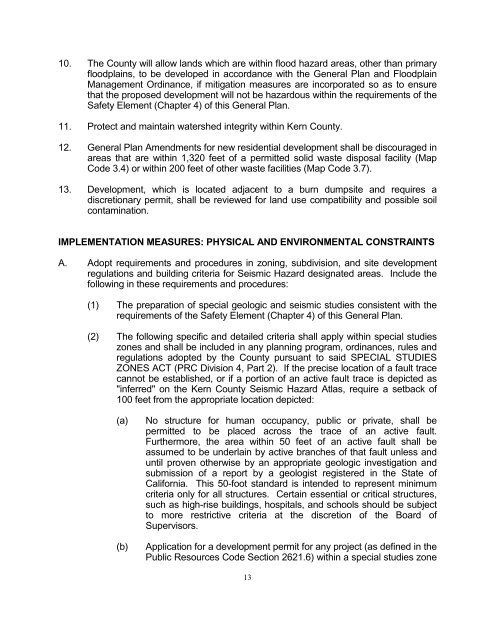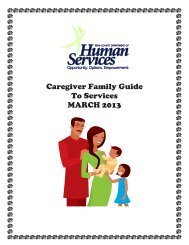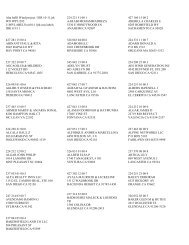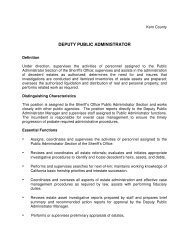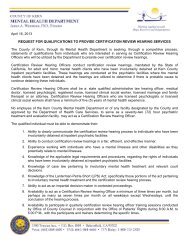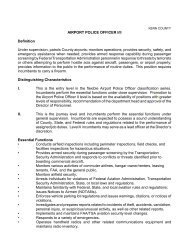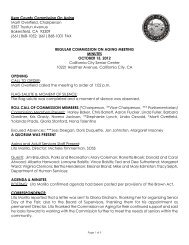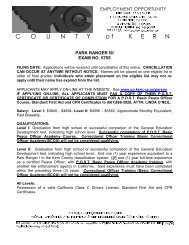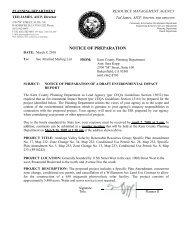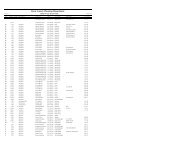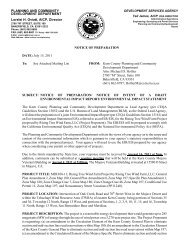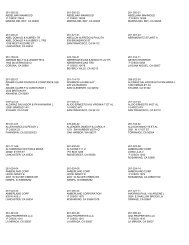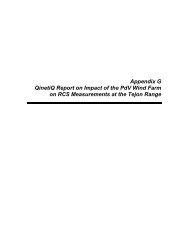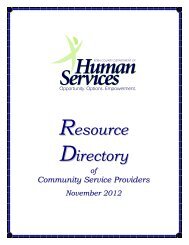Kern County General Plan - Chapter 1, Land Use - County of Kern
Kern County General Plan - Chapter 1, Land Use - County of Kern
Kern County General Plan - Chapter 1, Land Use - County of Kern
You also want an ePaper? Increase the reach of your titles
YUMPU automatically turns print PDFs into web optimized ePapers that Google loves.
10. The <strong>County</strong> will allow lands which are within flood hazard areas, other than primary<br />
floodplains, to be developed in accordance with the <strong>General</strong> <strong>Plan</strong> and Floodplain<br />
Management Ordinance, if mitigation measures are incorporated so as to ensure<br />
that the proposed development will not be hazardous within the requirements <strong>of</strong> the<br />
Safety Element (<strong>Chapter</strong> 4) <strong>of</strong> this <strong>General</strong> <strong>Plan</strong>.<br />
11. Protect and maintain watershed integrity within <strong>Kern</strong> <strong>County</strong>.<br />
12. <strong>General</strong> <strong>Plan</strong> Amendments for new residential development shall be discouraged in<br />
areas that are within 1,320 feet <strong>of</strong> a permitted solid waste disposal facility (Map<br />
Code 3.4) or within 200 feet <strong>of</strong> other waste facilities (Map Code 3.7).<br />
13. Development, which is located adjacent to a burn dumpsite and requires a<br />
discretionary permit, shall be reviewed for land use compatibility and possible soil<br />
contamination.<br />
IMPLEMENTATION MEASURES: PHYSICAL AND ENVIRONMENTAL CONSTRAINTS<br />
A. Adopt requirements and procedures in zoning, subdivision, and site development<br />
regulations and building criteria for Seismic Hazard designated areas. Include the<br />
following in these requirements and procedures:<br />
(1) The preparation <strong>of</strong> special geologic and seismic studies consistent with the<br />
requirements <strong>of</strong> the Safety Element (<strong>Chapter</strong> 4) <strong>of</strong> this <strong>General</strong> <strong>Plan</strong>.<br />
(2) The following specific and detailed criteria shall apply within special studies<br />
zones and shall be included in any planning program, ordinances, rules and<br />
regulations adopted by the <strong>County</strong> pursuant to said SPECIAL STUDIES<br />
ZONES ACT (PRC Division 4, Part 2). If the precise location <strong>of</strong> a fault trace<br />
cannot be established, or if a portion <strong>of</strong> an active fault trace is depicted as<br />
"inferred" on the <strong>Kern</strong> <strong>County</strong> Seismic Hazard Atlas, require a setback <strong>of</strong><br />
100 feet from the appropriate location depicted:<br />
(a) No structure for human occupancy, public or private, shall be<br />
permitted to be placed across the trace <strong>of</strong> an active fault.<br />
Furthermore, the area within 50 feet <strong>of</strong> an active fault shall be<br />
assumed to be underlain by active branches <strong>of</strong> that fault unless and<br />
until proven otherwise by an appropriate geologic investigation and<br />
submission <strong>of</strong> a report by a geologist registered in the State <strong>of</strong><br />
California. This 50-foot standard is intended to represent minimum<br />
criteria only for all structures. Certain essential or critical structures,<br />
such as high-rise buildings, hospitals, and schools should be subject<br />
to more restrictive criteria at the discretion <strong>of</strong> the Board <strong>of</strong><br />
Supervisors.<br />
(b) Application for a development permit for any project (as defined in the<br />
Public Resources Code Section 2621.6) within a special studies zone<br />
13


